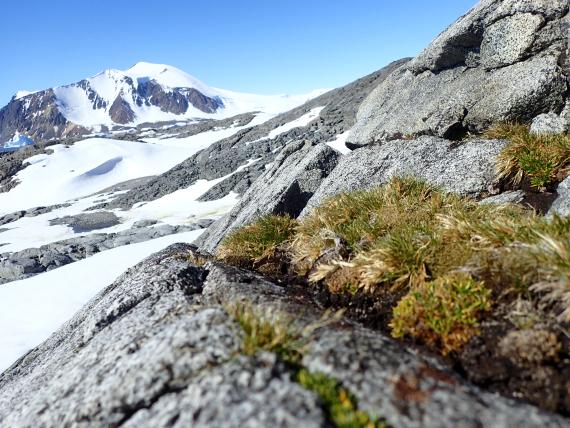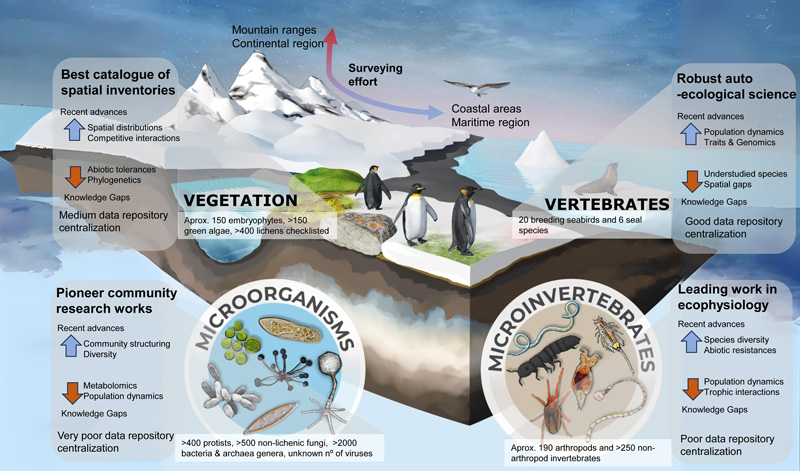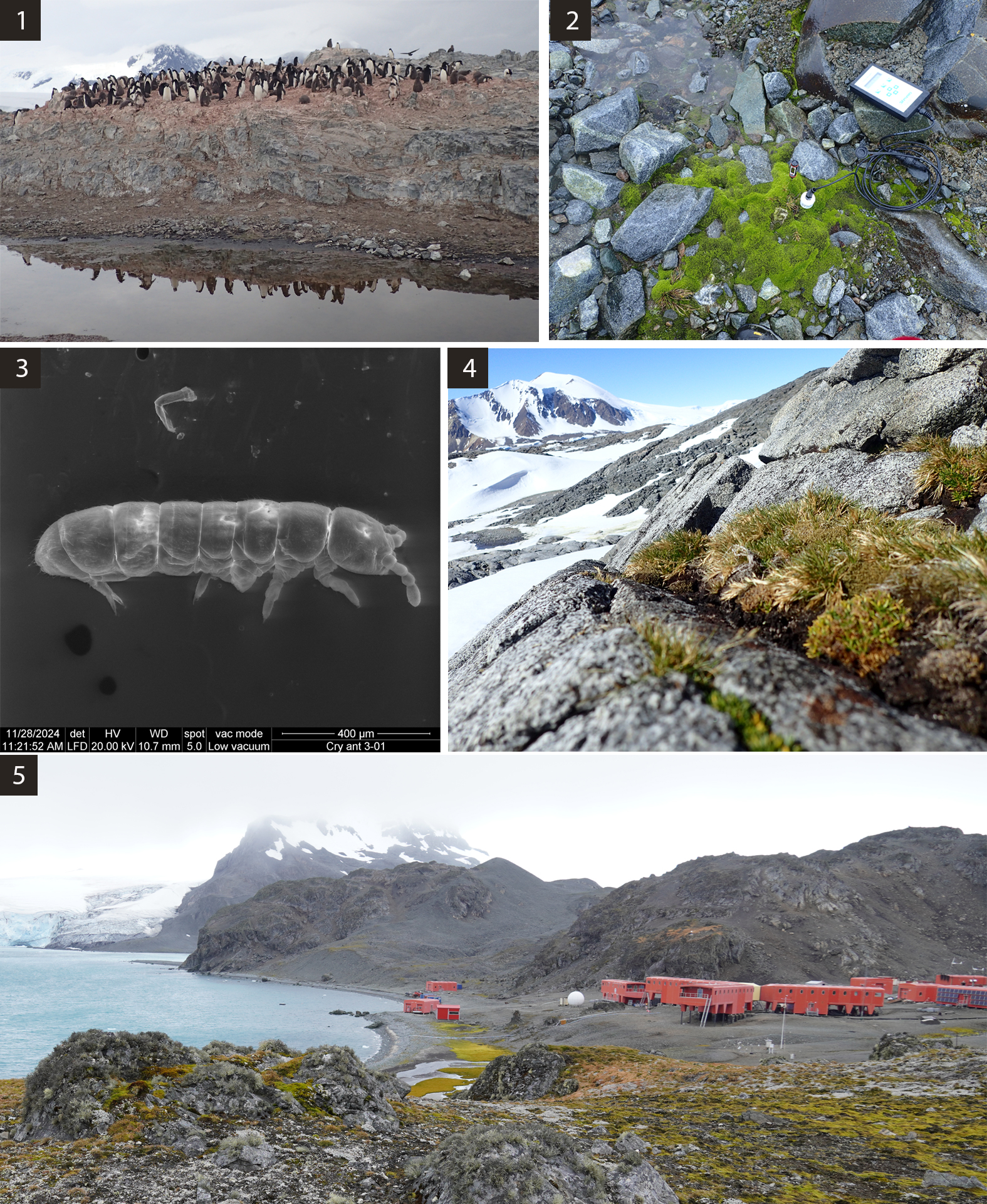Biased knowledge of the biodiversity and functioning of Antarctic ecosystems hampers their conservation

Today in Science, an international study was published, which analyses our level of knowledge surrounding Antarctic biodiversity, describing both the advances in research, as well as the gaps that still exist, identifying the great unknowns still to be discovered about its ecology and evolution. The results show that, although quite a lot is known about the biology of marine vertebrates that reproduce on the coast such as penguins and seals, there is still much to be discovered about a part of the diversity and the workings of the land ecosystems of the frozen continent. The researchers highlight the need to invest more into taxonomic studies about cryptic groups, monitoring populations, regional samples in less ecplored areas and physiological solutions. As noted in the study, led by the National Museum of National Sciences (MNCN-CSIC) and the Institute of Research of Global Change by the University Rey Juan Carlos (IICG-URJC), it is equally necessary to standardise methods, integration and accessibility of data.

“This study has allowed us to have a complete vision of the ecological knowledge of all this continent, for the first time ever, establishing the guidelines for disseminating these kinds of studies to Europe and other territories with much more complexity” announced Luis R. Pertierra, leader of this study. “This is, to understand what we know and what we do not, to form a foundation for identifying what is left to be known”
A lot is known about penguins or seals, but there is a generalized lack of information on microinvertebrates, microorganisms, or plants
“The Antarctic is one of the few territories of the planet that has been left practically pristine, with some environmental characteristic that allow it to house a unique biodiversity” explained the MNCN researcher Asunción de los Ríos. “The research into the continent of ice started nearly 2 centuries ago and its study has revealed important discoveries surrounding evolution and the functions of life in such isolated places with such extreme climate conditions” the researcher commented. “What´s more, it pertains to ecosystems that carry out important functions, like weather regulation, and because of this it is key to understand how they are being affected by climate change”, asserted Leopoldo García Sancho, a researcher at Madrid Complutense University. This study confirms that more than 2,000 species of terrestrial fauna, microbiota and flora have already been described for an apparently inert system surrounded by ice, but that many more remain to be discovered. Added to this is the difficulty of accessing tens of thousands of microorganisms (such as bacteria and viruses) that are predictably under the ice. As a result, what we know about the properties of these organisms is much scarcer still, and highly variable among different groups.
Published in Science, the article proposes standardizing study methods and integrating and improving accessibility to available data
“We are at a critical point in which it is necessary to stop and analyse what we know and what is left to discover about this fascinating continent, in order to manage our subsequent research efforts” noted Pertierra. It is for this reason that scientists from all over the world have met in this study to analyse the gaps in knowledge about Antarctic biodiversity. Amongst its authors are Andrés Barbosa, an important member of the Scientific Committee for Antarctic Research (SCAR) and who was also the coordinator of Spanish research in this continent, who tragically passed away two years ago now, and to whom this study is dedicated.

This international group of researchers has compiled and analysed the information collected in the main global databases on biodiversity; “large repositories such as GBIF, which compiles spatial occurrence data, or GenBank, which gathers genetic information, allow us both to examine the distribution of biodiversity and to identify gaps in our knowledge about it,” says Cristina Ronquillo, co-author of the study, who works at the MNCN. The analysis of this extensive data shows that, among animals (almost 400 species), the leading role is largely played by some twenty vertebrates, with a minority, but growing, knowledge of invertebrates. It should be noted that this systematized knowledge is mainly aimed at describing the climatic tolerances of the species”, stresses Miguel Ángel Olalla Tárraga, researcher in the IICG-URJC. This is probably due to the fact that “we have a pressing demand for information in order to understand species responses to rising temperatures”, as Pablo Escribano, also from the URJC, comments. On the other hand, we barely know the structure of the food webs in Antarctic ecosystems. “Basically, our knowledge is limited to an approximate idea of who eats whom,” says Pertierra.
The article sets the guidelines for obtaining a comprehensive view of what is known and unknown about this continent.
We also lack a lot of information about the functional traits of most species, it is difficult to identify the mechanisms that allow sthem to adapt their physiology to extreme conditions. In the case of flora, we have a wide understanding of their distribution, constantly improving thanks to satellite measures, that identify areas of vegetation in high resolution images. But again, this knowledge is not supported by advances in other disciplines. “For example, we hardly know anything about their evolutionary relationships, or the nature of their interactions,” says Pertierra. The lack of knowledge about microorganisms is even greater. “Recent studies on the functioning and nutrient flows in communities of microorganisms, as well as their movement from one area to another, give us clues as to how microscopic life develops in such an extreme climate,” adds Antonio Quesada, a researcher at the Autonomous University of Madrid.
The paper emphasises that this imbalance in the knowledge of the biology of so many groups of organisms prevents us from understanding how ecological processes develop in Antarctica, which is key to guiding conservation measures in the face of global change. “Analyses of biodiversity knowledge gaps allow us to identify major research needs in the coming years. In the case of Antarctica, it is necessary to invest in taxonomic research, monitor populations, identify model species, standardize the study methods we use and integrate the data we obtain. These are some of the measures we propose to solve the unknowns we have about this important and fascinating territory”, concludes Joaquín Hortal, also a researcher at the MNCN.
Investigador
Luis R. Pertierra Asunción de los Ríos Joaquín HortalReferencias
Pertierra LR, Convey P, Barbosa A, Biersma EM, Cowan D, et al. (2025) Advances and shortfalls in the knowledge of Antarctic terrestrial biodiversity. Science. DOI:











